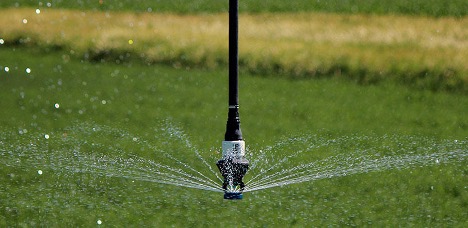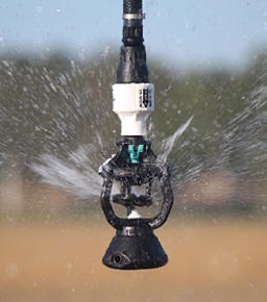Rotating vs. Fixed Sprinkler Heads

Why do we put sprinkler heads on center pivots?
The sprinkler head is designed to spread the water out over a large area. We do this to decrease the amount of water the soil has to intake during the period the sprinkler’s head is over that soil. This is called“instantaneous infiltration rate” and is a key to water uniformity and efficiency. When we overload the soil, we get run off and decrease our efficiency and uniformity.
There are two primary types of sprinkler heads that we sell, a fixed type and a rotating or wobbling type. I will discuss the pros and cons of both types in this blog post.
Fixed heads have no moving parts and usually spray in a sort of “donut” pattern where the water falls in a circle some distance from the head. This pattern can tend to overload the soil’s ability to intake water in that donut and can lead to some runoff. Fixed heads are usually less expensive, and don’t wear out as quickly as rotating sprays.

Rotating heads have a moving spray pad that greatly increases the uniformity of the spray pattern under the head. They can water nearly the entire circle under their head, which reduces the chances of water running off. Rotating heads are more expensive and have a shorter life span. Some rotators may need to be replaced every ten years or so, depending on water conditions.

So which type of sprinkler head should you choose? Well, that depends on some different conditions that you will encounter in your field. Coarser, more loose soils (like sand) have a greater intake rate, and its less important to get the water spread out. Tighter, more claylike soil shave lower intake rate, and its more important to get the water spread out.
Higher gallonage systems putout many more gallons per acre, and can increase runoff with fixed heads. Topography of the field (flat vs steep) can also increase runoff.
Agronmic conditions also play a role. Having a greater amount of plant material (trash) on the soil surface can decrease the energy each drop expends when it hits the ground, and can significantly increase the intake rate. Bare soils can seal off much more quickly, and cause a great deal of runoff.
This choice ultimately comes down to the trade offs the individual farmer is willing to make and the benefits he/she thinks they will receive from the different types.

